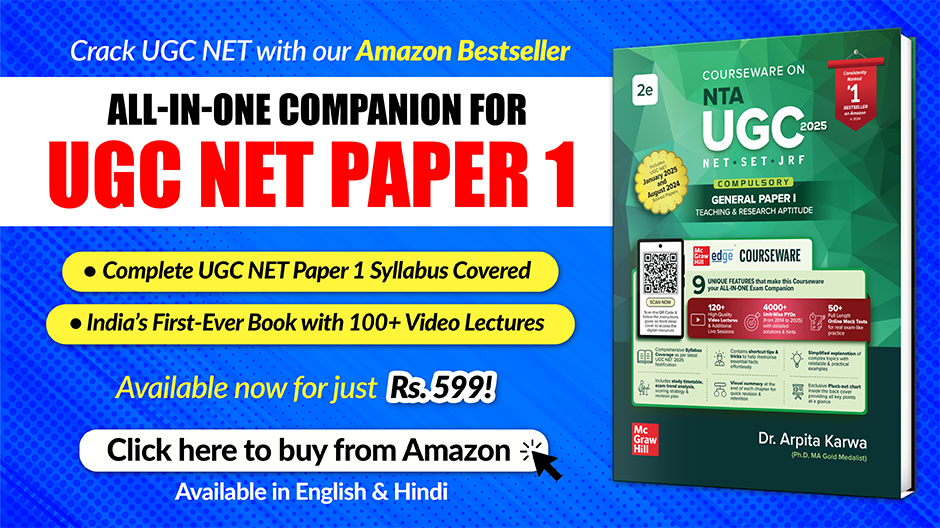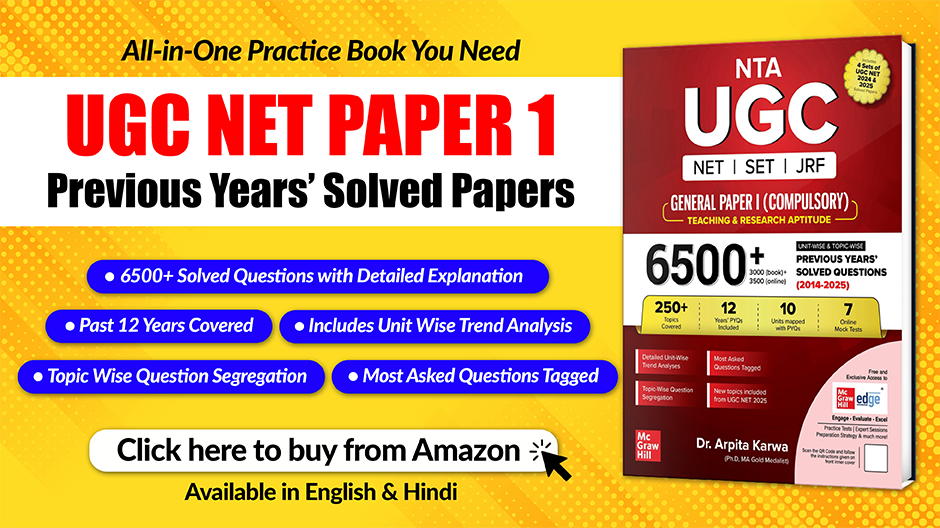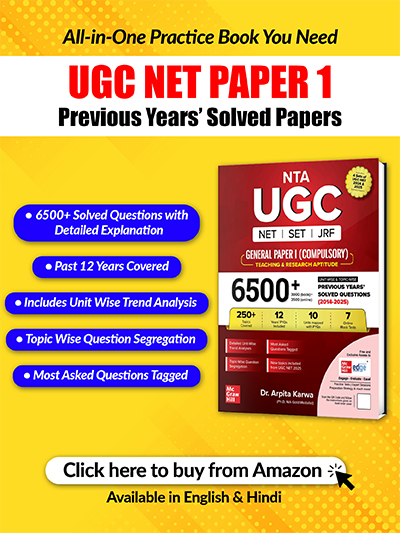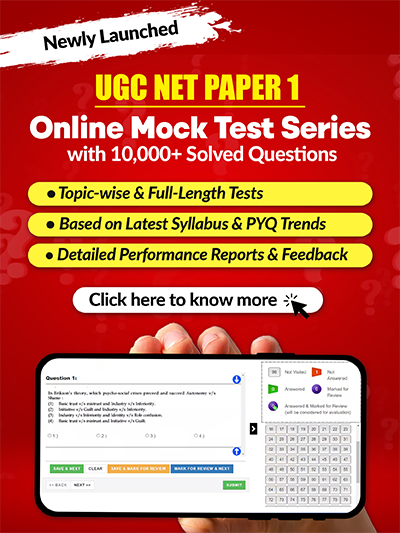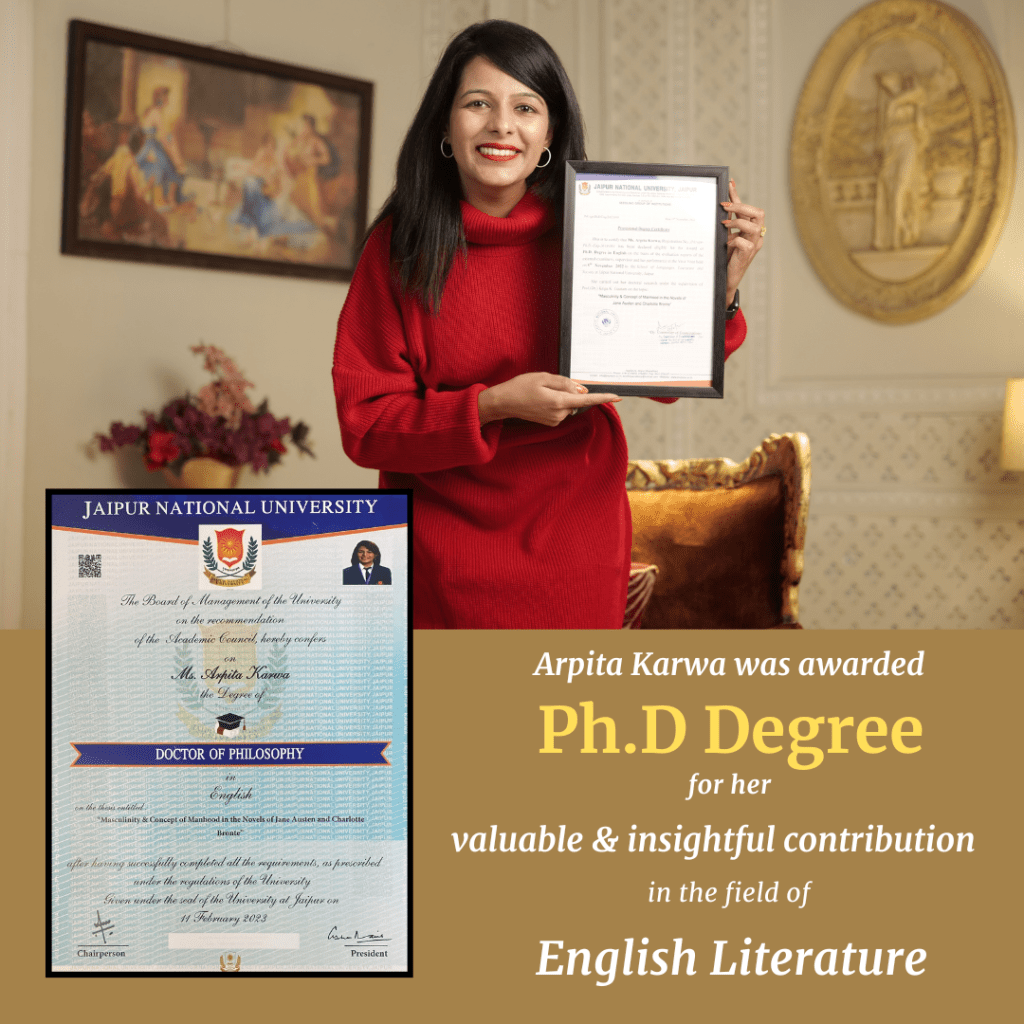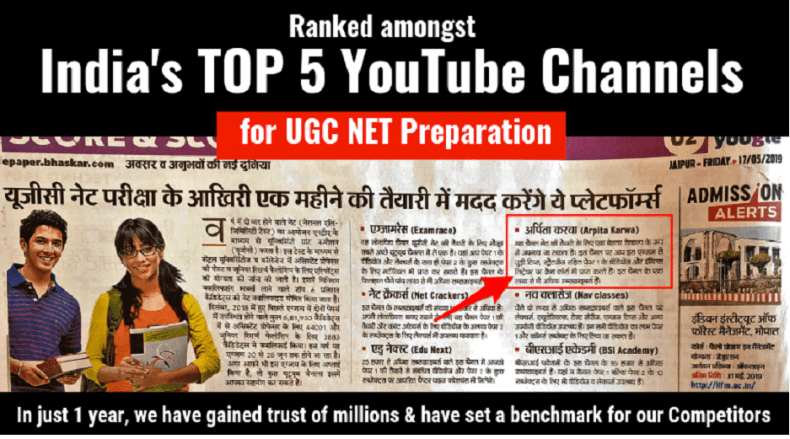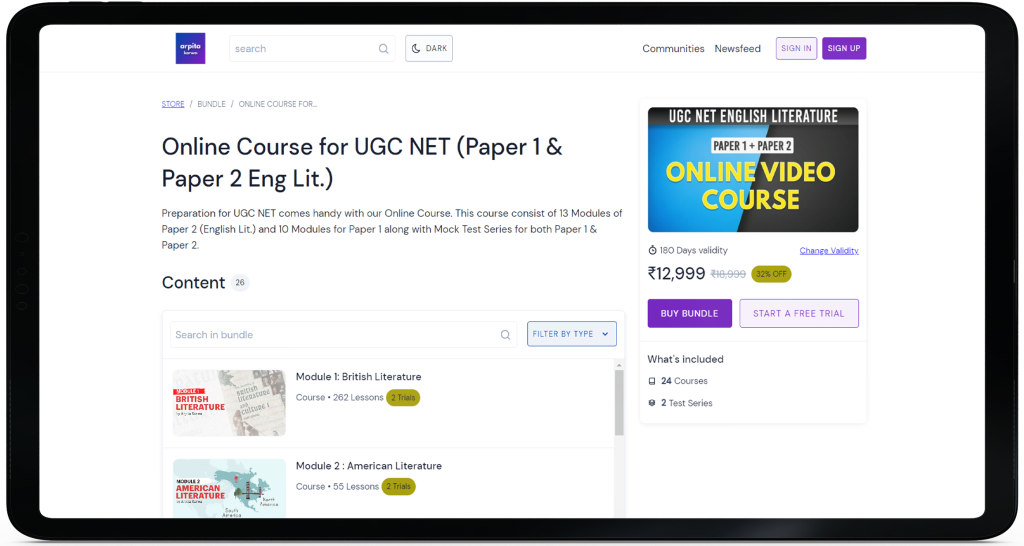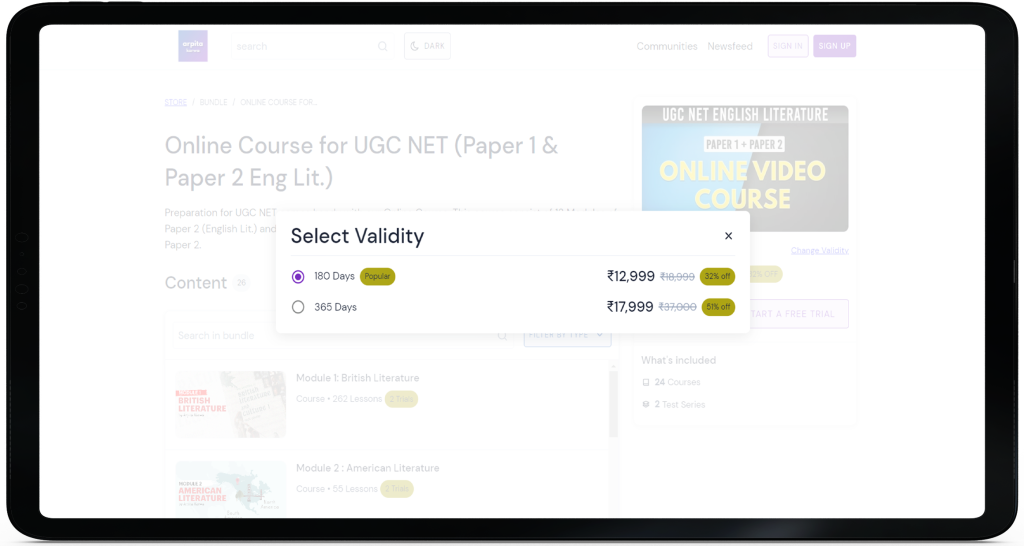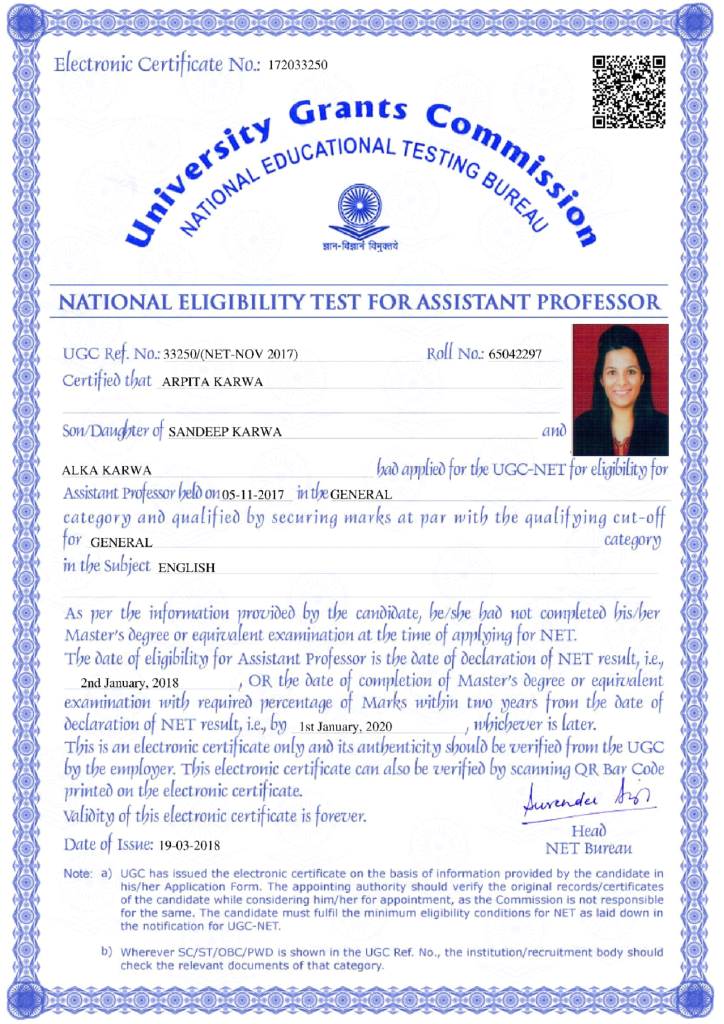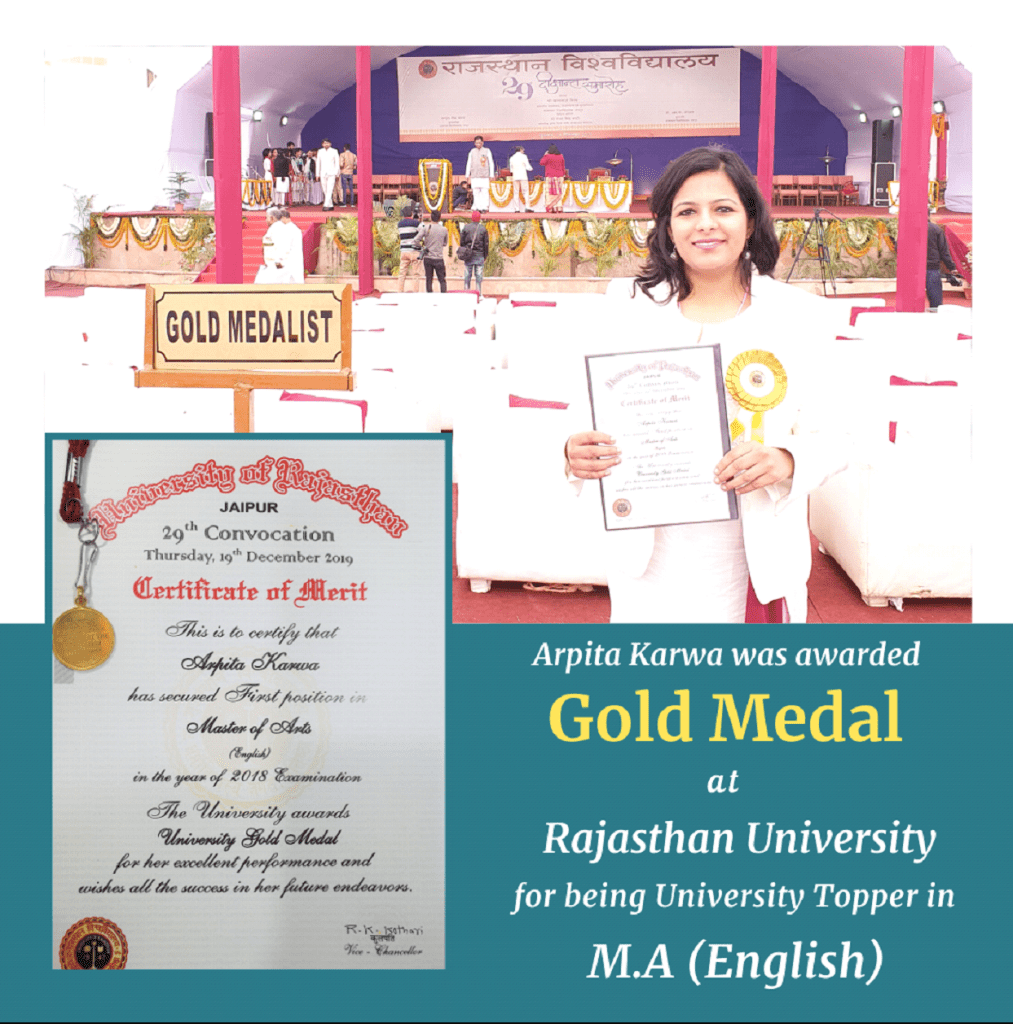UGC NET Paper 1 October 2020 (Conducted on 1st October 2020 : Morning Shift)
October 18, 2022 2025-08-18 14:00UGC NET Paper 1 October 2020 (Conducted on 1st October 2020 : Morning Shift)
October 2020: Paper 1 (Conducted on 1st Oct 2020 : Morning Shift)
Q.1-5)
Q.1) What is the difference between the total number of students who appeared in the exam and the total number of students who passed in the exam from Zone-K in all the six years taken together?
[1] 2060
[2] 2070
[3] 2080
[4] 2090
Correct Answer: 4
Q.2) What is the average number of students who passed in the exam from all the four Zones in the year 2015?
[1] 528
[2] 529
[3] 530
[4] 531
Correct Answer: 2
Q.3) For which of the following Zones, the percentage of students who passed out to the total of those who appeared in the examination is minimum in the year 2019?
[1] K
[2] L
[3] M
[4] N
Correct Answer: 2
Q.4) What is the ratio of the number of students who passed from Zone-K in the year 2017 compared to that in 2018?
[1] 7:5
[2] 3:5
[3] 5:7
[4] 5:3
Correct Answer: 3
Q.5) The total number of students who passed from Zone-M in all the six years taken together is approximately what percentage of the total number of students who appeared from Zone-M in all the six years taken together?
[1] 56%
[2] 58%
[3] 60%
[4] 64%
Correct Answer: 3
Q.6) Identify those teaching strategies which are learner-centred
A. Cooperative learning
B. Team teaching
C. Laboratory based projects
D. Pair-share discussions
E. Lecturing with PowerPoint presentations
[1] ABC
[2] BCD
[3] ACD
[4] CDE
Correct Answer: 3
Q.7) Reflective level teaching is different from memory level teaching because the pattern of communication that is involved in reflective level teaching is basically
[1] Linear
[2] Bottom-up
[3] Interactional
[4] Transactional
Correct Answer: 4
Q.8) From the following, identify those features which are associated with indirect Instructional Strategies:
A. Guided student practice
B. Focus on concept acquisition through question-answer sessions
C. Presenting the stimulus material in small, easy to take steps
D. Problem based presentation
E. Participatory and collaborative moves stressed
[1] BDE
[2] ABC
[3] BCD
[4] CDE
Correct Answer: 1
Q.9) Which one of the following assessment procedures is conducted during an in-progress teaching-learning session?
[1] Summative
[2] Formative
[3] Norm-referenced
[4] Criterion-referenced
Correct Answer: 2
Q.10) Statement I: The use of ICT in organizing teaching-learning programmes in the universities has the potential to optimise learning outcomes
Statement Il: Formative assessment provides support to enhancing the quality of teaching- learning sessions
[1] Both Statement I and Statement Il are correct
[2] Both Statement I and Statement Il are incorrect
[3] Statement I is correct but Statement Il is incorrect
[4] Statement I is incorrect but Statement Il is correct
Correct Answer: 1
Q.11) Identify sampling procedures in which units are chosen giving an equal and independent chance
A. Quota sampling procedure
B. Stratified sampling procedure
C. Dimensional sampling procedure
D. Random sampling procedure
E. Systematic sampling procedure
[1] A, B, and C only
[2] B, C and D only
[3] C, Dand E only
[4] B, D and E only
Correct Answer: 4
Q.12) Statement I: Qualitative research paradigm emphasizes participant perspectives and uses an empirico-inductive approach
Statement Il: In the same research project, it is neither possible nor desirable to use both Qualitative and Quantitative research paradigms
[1] Both Statement I and Statement Il are correct
[2] Both Statement I and Statement II are incorrect
[3] Statement I is correct but Statement Il is incorrect
[4] Statement I is incorrect but Statement Il is correct
Correct Answer: 3
Q.13) The research method which focuses on establishing causal relationships with controls among variables – independent, moderator and dependent, is called
[1] Ex post facto method
[2] Survey method
[3] Case study method
[4] Experimental method
Correct Answer: 4
Q.14) What are the characteristic features of the Quantitative Research paradigm?
A. It is hypothetico-deductive
B. It is focused on natural settings
C. It lays stress on generalizations to the population characteristics
D. It emphasizes numeric data from a large number of people
E. It says that the literature review plays a minor role but justify the problem
[1] ACD
[2] ABC
[3] BCD
[4] CDE
Correct Answer: 1
Q.15) What is the usual sequence of steps in the scientific method?
A. Hypothesis making by identifying the variables
B. Felt need which is creating the problem
C. Identifying the difficulty and problem statement formulation
D. Data analysis and interpretation
E. Collection of data using appropriate research tools
[1] ACBDE
[2] BCAED
[3] CDEBA
[4] BACED
Correct Answer: 2
Q.16) In communication, interpretation of the message depends upon
[1] The context
[2] Transmission speed
[3] Associated noise
[4] Channel efficiency
Correct Answer: 1
Q.17) Which of the following factors are important in communication?
A. Slang
B. Cynical attitude
C. Framing
D. Priming
E. Immediacy
[1] ABC
[2] BCD
[3] ADE
[4] CDE
Correct Answer: 4
Q.18) The sequence of cultural institutions in communication is
A. Family
B. School
C. Religion
D. Mass media
[1] ABCD
[2] BCDA
[3] CDAB
[4] DABC
Correct Answer: 1
Q.19) Assertion A: Giving orders to students in the classroom is a specific form of communication
Reason R: The manner of orders depends upon the cultural background of the students involved
[1] Both A and R are true and R is the correct explanation of A
[2] Both A and R are true but R is NOT the correct explanation of A
[3] A is true but R is false
[4] A is false but R is true
Correct Answer: 1
Q.20) Match the column:
A. meaningless sound and words
B. traffic light signals
C. word that have different meanings
D. two persons exchanging greetings
I. polysemy
II. dyadic communication
III. paralinguistic
IV. non-verbal communication
[1] A-I B-II C-IV D-III
[2] A-II B-III C-I D-IV
[3] A-III B-IV C-I D-II
[4] A-IV B-I C-II D-III
Correct Answer: 3
Q.21) The product of the ages of Sagun and Srishti is 240. If twice the age of Srishti is more than Sagun’s age by 4 years, then what is Srishti’s age?
[1] 15
[2] 12
[3] 10
[4] 20
Correct Answer: 2
Q.22) Complete the following series
9,11,15,23,39, ___?
[1] 71
[2] 65
[3] 44
[4] 68
Correct Answer: 1
Q.23) Statement I: Sum of the angles of a triangle is 180°
Statement II: The sum of any two sides of a triangle is greater than the third side
[1] Both Statement I and Statement Il are true
[2] Both Statement I and Statement Il are false
[3] Statement I is correct but Statement Il is false
[4] Statement I is incorrect but Statement Il is true
Correct Answer: 1
Q.24) Consider the following three sets of numbers
A. 2,5,9
B. 1,6,10
C. 3,4,8
Which of the following represents correct ascending order of the averages of three sets A, B and C?
[1] C < A < B
[2] B < C < A
[3] B < A < C
[4] C < B < A
Correct Answer: 1
Q.25) If 30% of A=0.25 of B=1/5 of C, then which of the following is true about A:B:C?
[1] 10:11:12
[2] 10:15:12
[3] 10:12:15
[4] 10:11:15
Correct Answer: 3
Q.26) A, B, C, D, E and F are standing in a circle and looking at the centre. Only D is between A an B. Only Fis between A and C. E is just left of B. Who is the only one standing between E and F?
[1] A
[2] B
[3] D
[4] C
Correct Answer: 4
Q.27) All things which have smoke have fire;
This hill has smoke;
Therefore, The hill has smoke; and
No non-fiery things have smoke;
This hill has smoke;
Therefore, this hill is not non-fiery
The above is an example of which type of inference in Indian logic?
[1] Purvavat
[2] Anvayavyatireki
[3] Kevalanvayi
[4] Kevalavyatireki
Correct Answer: 2
Q.28) Asidha is a fallacy when the middle term is
[1] Unproved
[2] Too wide
[3] Too narrow
[4] Non-exclusive
Correct Answer: 1
Q.29) Match the column:
A. assign : allot
B. length : meter
C. doctor : hospital
D. lock : key
I. code : password
II. clerk : office
III. mend : repair
IV. mass : kilogram
[1] A-III B-IV C-II D-I
[2] A-IV B-II C-III D-I
[3] A-II B-IV C-I D-III
[4] A-IV B-III C-II D-I
Correct Answer: 1
Q.30) A man is facing south-west. If he turns 90° in the anticlockwise direction and then 135° in the clockwise direction, which direction is he facing now?
[1] West
[2] North-West
[3] North-East
[4] East
Correct Answer: 1
Q.31) RAM is placed on-
[1] Hard Disk
[2] Extension board
[3] Motherboard
[4] USB
Correct Answer: 3
Q.32) Which of the following statements are correct?
A. NKN stands for New Knowledge Network
B. MOOCs are offline courses
C. National Supercomputing Mission is a Government of India initiative
D. Clock rate of CPU is measured in Gigabytes
E. Param Shivay is a super computer
[1] CE
[2] BC
[3] CD
[4] AE
Correct Answer: 1
Q.33) Statement I: Cache memory is faster than random access memory
Statement II: Random access memory is closer to the processor than cache memory
[1] Both Statement I and Statement Il are correct
[2] Both Statement I and Statement Il are incorrect
[3] Statement I is correct but Statement Il is incorrect
[4] Statement I is incorrect but Statement Il is correct
Correct Answer: 3
Q.34) Which one of the following is NOT a web browser?
[1] Firefox
[2] Facebook
[3] Chrome
[4] Safari
Correct Answer: 2
Q.35) URL stands for
[1] Universal Resource Location
[2] Universal Response Locator
[3] Unified Response Location
[4] Uniform Resource Locator
Correct Answer: 4
Q.36) Dissolved oxygen (DO), an important parameter of water quality, is essential for survival of
[1] Humans
[2] Animals
[3] Fish
[4] Crops and vegetables
Correct Answer: 3
Q.37) Among the following elements which is typically the most abundant in dried sewage sludge?
[1] Total nitrogen
[2] Total sulphur
[3] Calcium
[4] Total phosphorous
Correct Answer: 3
Q.38) Identify the correct sequence of sectoral global CO2 emissions in increasing order as per IPCC (2014) report
A. Electricity and heat production
B. Buildings
C. Transportation
D. Industry
[1] B,C,D A
[2] B,C A D
[3] B,D,C A
[4] B D, A C
Correct Answer: 1
Q.39) Under Goal 2 of Millennium Development Goals, UN member countries were to ensure that by 2015, children everywhere, boys and girls would be able to complete a full course of
[1] Primary education
[2] Secondary education
[3] Tertiary education
[4] Skill based education
Correct Answer: 1
Q.40) Statement I: A deemed to be university is a non-affiliating university
Statement II: The teacher-student ratio in a deemed to be university must not be less than 1:10
[1] Both Statement I and Statement Il are true
[2] Both Statement I and Statement Il are false
[3] Statement I is correct but Statement II is false
[4] Statement I is incorrect but Statement II is true
Correct Answer: 3
Q.41) According to the census of 2011, which state/union territory had the maximum number of graduates in relation to its population?
[1] Uttar Pradesh
[2] Kerala
[3] Daman and Diu
[4] Chandigarh
Correct Answer: 4
Q.42) The full form of ‘NEAT’, a recently launched scheme of MHRD, Government of India, is
[1] National Engineering Aptitude Test
[2] National Educational Alliance for Technology
[3] National Education Alliance for Testing
[4] National English Aptitude Test
Correct Answer: 2
Q.43) An Inter-University Center for Yogic sciences has been set up by University Grants Commission in the state of
[1] Karnataka
[2] Madhya Pradesh
[3] Uttarakhand
[4] Himachal Pradesh
Correct Answer: 1
Q. 44-48)
Read RC Passage to Answer:
In Skinner’s system, reinforcement is automatic, almost by definition. Perhaps the most convincing demonstration of the automatic effect of a reinforcer is what Skinner (1948) has called “superstitious behaviour”. In this situation, an event known to be reinforcing is presented intermittently without respect to what the subject is doing. But if it is doing anything (and this can be made likely through deprivation, etc.), the response just prior to the delivery of the reinforcer is strengthened, as evidenced by an increase in its rate of emission. The subject comes to “act as if” the response that has been fortuitously strengthened somehow produces the reinforcement. This occurs even though the reinforcer is actually delivered by a mechanical device that is in no way responsive to the subject’s behaviour.
The automatic effect of reinforcement is also illustrated in Skinner’s effective techniques of shaping behaviour. These procedures could hardly have sprung from a point of view that regarded all behaviour as elicited. But with the organism viewed as “emitting” the varied responses already in his repertoire, it was an easy step to conceive of shaping. If the observer simply controlled the quick presentation of a reinforcer, then he could strengthen any behaviour the organism happened to emit. Responses not in the subject’s repertoire could then be built into it by appropriate arrangements of environmental conditions and the successive approximation technique.
Q.44) According to Skinner, the superstitious behaviour of individuals is the outcome of
[1] Constant exposure to an event
[2] Exposure to an event without regularity
[3] Occasional exposure to an event
[4] Natural exposure to an event
Correct Answer: 2
Q.45) The delivery of the reinforcer gets strengthened due to
[1] The subjects involvement in the event
[2] Increase in the rate of reinforcement
[3] Factors such as deprivation
[4] The use of a mechanical device
Correct Answer: 3
Q.46) The example of a mechanical device reinforcing the subject’s behaviour demonstrates
[1] The automatic effect of reinforcement
[2] The illusion of reinforcement
[3] The discrepancy in subject’s behaviour
[4] The belief that every reaction is an act of reinforcement
Correct Answer: 1
Q.47) The procedure of shaping a subject’s behaviour is related to his
A. Susceptibility
B. Desire for reinforcement
C. Responses already in his repertoire
D. Responses reinforced by approximation techniques
[1] AB
[2] BC
[3] CD
[4] AD
Correct Answer: 3
Q.48) The responses that are not in the emission list of a subject, can be observed by
[1] Coercive measures
[2] Creating suitable environmental conditions
[3] Inhibiting his natural emission behavior
[4] Using mechanical devices for reinforcement
Correct Answer: 2
